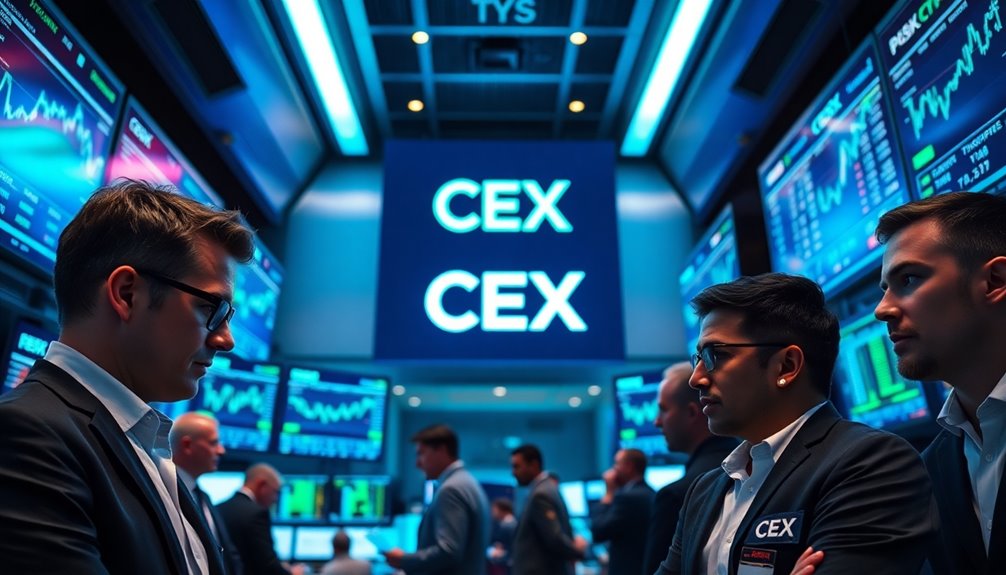A centralized exchange (CEX) is a platform where you can buy and sell cryptocurrencies easily. Think of it as a digital marketplace that connects you with other traders, handling your buy and sell orders efficiently. You'll deposit your assets into exchange-managed wallets, which means a central authority oversees your transactions. CEXs provide a user-friendly interface, integrating both cryptocurrencies and fiat. They also prioritize security, employing measures like two-factor authentication. With a growing market, they're becoming even more vital for crypto trading. Curious about how these platforms work or the differences with decentralized exchanges? Just stick around for more insights!
Key Takeaways
- Centralized exchanges (CEX) facilitate cryptocurrency trading by acting as intermediaries for buying and selling digital assets.
- Users deposit cryptocurrencies into exchange-controlled wallets, which introduces custodial risks but offers user-friendly interfaces.
- CEXs ensure high liquidity for quick trade executions and minimal price slippage through a structured order matching process.
- Security measures include two-factor authentication, cold storage solutions, and withdrawal whitelists to protect user accounts.
- Regulatory compliance is crucial for CEXs to operate legally and avoid penalties from varying state and federal regulations.
Centralized Exchange Overview

A centralized exchange (CEX) acts as a hub for cryptocurrency trading, providing users with a convenient platform to buy and sell digital assets. Managed by a central authority, it serves as an intermediary for order matching, trade execution, and user account management.
You'll deposit your cryptocurrencies into wallets controlled by the exchange, which handles the security and management of your assets. While this offers ease of use, it introduces custodial risks like hacking. Centralized exchanges provide an online marketplace for participants to exchange assets and offer custodial services, holding users' funds in wallets.
With user-friendly interfaces, CEXs cater to a broad audience, integrating fiat currencies and supporting various cryptocurrencies. High liquidity ensures quick trade executions, minimal price slippage, and efficient processes, making it a go-to platform for both novice and seasoned traders.
Understanding Centralized Exchanges

Centralized exchanges (CEXs) play a pivotal role in the cryptocurrency ecosystem by streamlining the trading process for users. They operate under a centralized authority, allowing you to create accounts and deposit cryptocurrencies into exchange-controlled wallets. To enhance security, CEXs implement measures like two-factor authentication (2FA), multi-signature wallets, and cold storage solutions to protect your assets. Regulatory compliance is also crucial, with rigorous Know Your Customer (KYC) and Anti-Money Laundering (AML) policies in place. These exchanges provide a user-friendly interface, facilitating the buying, selling, and trading of digital assets. Recent acquisitions following breaches have highlighted the importance of robust security measures in maintaining user trust. Regular security audits and adherence to industry standards further bolster user trust, ensuring a safer trading environment in a rapidly evolving landscape.
Order Matching Process Explained

In the world of centralized exchanges, the order matching process is at the heart of efficient trading.
You start by submitting your buy or sell orders through the exchange's platform, whether via web, mobile, or API. These orders enter the order book, where they're organized by price and time priority.
The exchange's matching engine then takes over, using algorithms to pair compatible orders in real-time. It ensures fairness and speed, replacing old face-to-face trading methods. This process is crucial for maintaining high liquidity in the market, allowing for large trades without significant price impact.
Different algorithms, like First-In-First-Out (FIFO) and Pro-Rata, help prioritize and execute trades efficiently, minimizing inefficiencies.
This entire process keeps the market transparent and ensures you get the best possible execution for your trades.
Pros and Cons Summary

While centralized exchanges (CEXs) offer numerous advantages, they also come with notable drawbacks that traders should consider.
On the plus side, CEXs provide user-friendly interfaces, high liquidity, a variety of services, and robust security measures. These features make trading easier, faster, and more accessible, especially for beginners. Additionally, they invest in advanced security measures to protect user data and funds.
However, they also pose risks, such as a lack of privacy due to KYC requirements and the potential loss of control over your funds, as exchanges hold your private keys.
Additionally, regulatory risks and higher fees can affect your trading experience. Security vulnerabilities remain a concern, given the history of hacks and insolvencies in the sector.
Weighing these pros and cons is essential before diving into a CEX.
CEX Versus DEX Analysis

When comparing CEXs and DEXs, it's crucial to understand how each platform handles asset custody, liquidity, and security.
CEXs hold your assets, making them convenient but also vulnerable to hacks. You won't control your private keys, limiting your access to DeFi and Web3 applications. Moreover, centralized exchanges provide a user-friendly experience, which helps beginners navigate the complexities of trading.
In terms of liquidity, CEXs often provide higher trading volumes and faster transactions due to their centralized order books. They're user-friendly, offering support that's ideal for beginners.
However, security is a concern; CEXs can face operational downtimes and hacking risks.
On the other hand, DEXs offer more security through decentralization but demand a higher level of understanding from you, as you manage your own keys and navigate complex processes.
Regulatory Compliance Issues

As regulatory frameworks for centralized exchanges (CEXs) evolve, staying compliant becomes a daunting challenge for operators and users alike.
CEXs face a patchwork of state money transmitter laws and FTC and CFPB regulations. The SEC and CFTC enforce compliance through actions that often create blanket risks, labeling most crypto marketplaces as unregistered securities exchanges. This leads to conflicting obligations, especially with varying requirements across states. The challenges are further compounded by the historical context of centralized exchanges, which have previously faced significant issues such as the Mt. Gox bankruptcy.
Recent crackdowns on exchanges like Coinbase and Binance underscore these challenges. As enforcement actions rise, including a 183% increase post-FTX collapse, the stakes are high.
For users, understanding these regulations is vital for picking trustworthy exchanges, while operators must prioritize compliance to ensure long-term success and avoid severe penalties.
Emergence of Hybrid Exchanges

The emergence of hybrid exchanges marks a significant evolution in the cryptocurrency trading landscape, combining the best features of centralized and decentralized platforms.
You'll find user-friendly interfaces and high liquidity, alongside enhanced security, privacy, and asset control. Hybrid exchanges are designed to mitigate vulnerabilities found in centralized exchanges while enhancing the trading experience.
These exchanges utilize blockchain settlement layers and smart contracts for efficient transaction handling, allowing you to manage your crypto assets without intermediaries.
Security Measures for User Accounts

Ensuring the security of your user account is crucial in today's digital landscape, especially in the world of cryptocurrency trading. To protect your account, enable Two-Factor Authentication (2FA) or Multi-Factor Authentication, adding extra layers with text messages or biometric tokens. Additionally, consider that AI cybersecurity jobs are on the rise, reflecting the growing need for robust security measures in all digital transactions.
Verify your identity through necessary documentation to prevent unauthorized access. For your funds, utilize cold storage for the majority, keeping only a small portion in hot wallets for transactions. Implement withdrawal whitelists to restrict transfers to approved addresses.
Regularly monitor your account for unusual activity and set up alerts for any suspicious logins. Always use secure connections, avoid public Wi-Fi, and stay educated on phishing scams to keep your account safe. The cryptocurrency exchange sector is projected to grow significantly, with market growth expected to reach $341,890.21 million by 2028.
Frequently Asked Questions
How Do Centralized Exchanges Earn Revenue?
Centralized exchanges earn revenue through various streams. They charge trading fees on every transaction, usually ranging from 0.1% to 0.25%.
You'll also encounter withdrawal and deposit fees that cover network costs. Additional services like margin trading and staking generate profits, as do premium memberships with reduced fees.
Listing new cryptocurrencies involves fees too. All these methods ensure a consistent revenue flow while enhancing your trading experience.
What Currencies Can I Trade on a CEX?
Imagine stepping into a vibrant marketplace where digital coins twinkle like stars.
You can trade popular currencies like Bitcoin (BTC) and Ethereum (ETH), alongside altcoins like Cardano (ADA) and Chainlink (LINK).
Don't forget about stablecoins like USDC and Tether, which offer stability amidst the hustle.
With a diverse array of options including Solana (SOL) and SHIBA INU (SHIB), you've got the perfect playground for your trading adventures.
Are There Withdrawal Limits on Centralized Exchanges?
Yes, there are withdrawal limits on centralized exchanges. You might face daily limits on fiat withdrawals or specific token limits based on your account type.
Sometimes, restrictions occur due to pending transfers, unverified accounts, or having open orders.
These limits can impact your liquidity and access to funds, so it's crucial to understand the specific rules of your chosen exchange to avoid unexpected delays or issues when trying to withdraw.
Can I Use a CEX Anonymously?
Imagine stepping into a bustling marketplace where every face is familiar and every transaction is recorded.
You might wish to trade without revealing your identity, but you can't do that here. Centralized exchanges require you to complete KYC verification, sharing personal details like your name and ID.
How Do I Choose the Best CEX for Trading?
To choose the best exchange for trading, start by assessing its security features and history of breaches.
Check for high liquidity and trading volumes to ensure quick transactions and fair prices.
Compare fees, including trading and withdrawal costs, to maximize your profits.
Look for a user-friendly interface and advanced trading tools.
Finally, consider customer support options and regulatory compliance to ensure a smooth trading experience tailored to your needs.
Conclusion
In the world of crypto, centralized exchanges offer convenience and speed, but they come with risks and concerns. While you can quickly buy and sell assets, you might worry about security and control. On the other hand, decentralized exchanges promise autonomy and privacy but can lack user-friendliness. As hybrid exchanges emerge, you'll find a balance between these worlds. Ultimately, it's about what suits your trading style and priorities—choose wisely, and stay informed.









